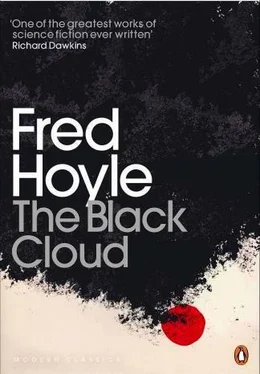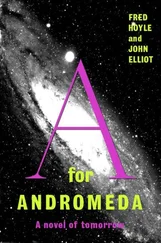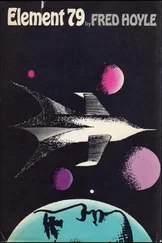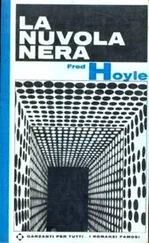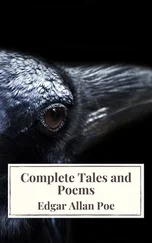Fred Hoyle - The Black Cloud
Здесь есть возможность читать онлайн «Fred Hoyle - The Black Cloud» весь текст электронной книги совершенно бесплатно (целиком полную версию без сокращений). В некоторых случаях можно слушать аудио, скачать через торрент в формате fb2 и присутствует краткое содержание. Жанр: Фантастика и фэнтези, на английском языке. Описание произведения, (предисловие) а так же отзывы посетителей доступны на портале библиотеки ЛибКат.
- Название:The Black Cloud
- Автор:
- Жанр:
- Год:неизвестен
- ISBN:нет данных
- Рейтинг книги:5 / 5. Голосов: 1
-
Избранное:Добавить в избранное
- Отзывы:
-
Ваша оценка:
- 100
- 1
- 2
- 3
- 4
- 5
The Black Cloud: краткое содержание, описание и аннотация
Предлагаем к чтению аннотацию, описание, краткое содержание или предисловие (зависит от того, что написал сам автор книги «The Black Cloud»). Если вы не нашли необходимую информацию о книге — напишите в комментариях, мы постараемся отыскать её.
The Black Cloud — читать онлайн бесплатно полную книгу (весь текст) целиком
Ниже представлен текст книги, разбитый по страницам. Система сохранения места последней прочитанной страницы, позволяет с удобством читать онлайн бесплатно книгу «The Black Cloud», без необходимости каждый раз заново искать на чём Вы остановились. Поставьте закладку, и сможете в любой момент перейти на страницу, на которой закончили чтение.
Интервал:
Закладка:
Dr Herrick, the Director of the Observatory, was astonished to find Marlowe waiting for him when he reached his office at seven-thirty the following morning. It was the Director’s habit to start his day some two hours before the main body of his staff, “in order to get some work done’, as he used to say. At the other extreme, Marlowe usually did not put in an appearance until ten-thirty, and sometimes later still. This day, however, Marlowe was sitting at his desk, carefully examining a pile of about a dozen positive prints. Herrick’s surprise was not lessened when he heard what Marlowe had to say. The two men spent the next hour and a half in earnest conversation. At about nine o’clock they slipped out for a quick breakfast, and returned in time to make preparations for a meeting to be held in the library at ten o’clock.
When Bill Barnett’s party of five arrived they found some dozen members of the Observatory already assembled, including Jensen, Rogers, Emerson, and Harvey Smith. A blackboard had been fitted up and a screen and lantern for showing slides. The only member of Barnett’s party who had to be introduced round was Dave Weichart. Marlowe, who had heard a number of reports of the abilities of this brilliant twenty-seven-year-old physicist, noted that Barnett had evidently done his best to bring a bright boy along.
“The best thing I can do,” began Marlowe, “is to explain things in a chronological way, starting with the plates that Knut Jensen brought to my house last night. When I’ve shown them you’ll see why this emergency meeting was called.”
Emerson, who was working the lantern, put in a slide that Marlowe had made up from Jensen’s first plate, the one taken on the night of 9 December 1963.
“The centre of the dark blob,” went on Marlowe, “is in Right Ascension 5 hours 49 minutes, Declination minus 30 degrees 16 minutes, as near as I can judge.”
“A fine example of a Bok globule,” said Barnett.
“How big is it?”
“About two and a half degrees across.”
There were gasps from several of the astronomers.
“Geoff, you can keep your bottle of whisky,” said Harvey Smith.
“And my crate, too,” added Bill Barnett amidst the general laughter.
“I reckon you’ll be needing the whisky when you see the next plate. Bert, keep rocking the two backwards and forwards, so that we can get some idea of a comparison,” went on Marlowe.
“It’s fantastic,” burst out Rogers, “it looks as if there’s a whole ring of oscillating stars surrounding the cloud. But how could that be?”
“It can’t,” answered Marlowe. “That’s what I saw straight away. Even if we admit the unlikely hypothesis that this cloud is surrounded by a halo of variable stars, it is surely quite inconceivable that they’d all oscillate in phase with each other, all up together as in the first slide, and all down together as in the second.”
“No, that’s preposterous,” broke in Barnett. “If we’re to take it that there’s been no slip-up in the photography, then surely there’s only one possible explanation. The cloud is moving towards us. In the second slide it’s nearer to us, and therefore it’s obscuring more of the distant stars. At what interval apart were the two plates taken?”
“Rather less than a month.”
“Then there must be something wrong with the photography.”
“That’s exactly the way I reasoned last night. But as I couldn’t see anything wrong with the plates, the obvious thing was to take some new pictures. If a month made all that difference between Jensen’s first plate and his second, then the effect should have been easily detectable in a week — Jensen’s last plate was taken on 7 January. Yesterday was 14 January. So I rushed up to Mount Wilson, bullied Harvey off the 60-inch, and spent the night photographing the edges of the cloud. I’ve got a whole collection of new slides here. They’re not of course on the same scale as Jensen’s plates, but you’Il be able to see pretty well what’s happening. Put them through one by one, Bert, and keep referring back to Jensen’s plate of 7 January.”
There was almost dead silence for the next quarter of an hour, as the star fields on the edge of the cloud were carefully compared by the assembled astronomers. At the end Barnett said:
“I give up. As far as I’m concerned there isn’t a shadow of a doubt but that this cloud is travelling towards us.”
And it was clear that he had expressed the conviction of the meeting. The stars at the edge of the cloud were being steadily blacked out as it advanced towards the solar system.
“Actually there’s no doubt at all about it,” went on Marlowe. “When I discussed things with Dr Herrick earlier this morning he pointed out that we have a photograph taken twenty years ago of this part of the sky.”
Herrick produced the photograph.
“We haven’t had time to make up a slide,” said he, “so you will have to hand it round. You can see the black cloud, but it’s small on this picture, no more than a tiny globule. I’ve marked it with an arrow.”
He handed the picture to Emerson who, after passing it to Harvey Smith, said:
“It’s certainly grown enormously over the twenty years. I’m a bit apprehensive about what’s going to happen in the next twenty. It seems as if it might cover the whole constellation of Orion. Pretty soon astronomers will be out of business.”
It was then that Dave Weichart spoke up for the first time.
“I’ve two questions that I’d like to ask. The first is about the position of the cloud. As I understand what you’ve said, the cloud is growing in its apparent size because it’s getting nearer to us. That’s clear enough. But what I’d like to know is whether the centre of the cloud is staying in the same position, or does it seem to be moving against the background of the stars?”
“A very good question. The centre seems, over the last twenty years, to have moved very little relative to the star field,” answered Herrick.
“Then that means the cloud is coming dead at the solar system.”
Weichart was used to thinking more quickly than other people, so when he saw hesitation to accept his conclusion, he went to the blackboard.
“I can make it clear with a picture. Here’s the Earth. Let’s suppose first that the cloud is moving dead towards us, like this, from A to B .

Then at B the cloud will look bigger but its centre will be in the same direction. This is the case that apparently corresponds pretty well to the observed situation.”
There was a general murmur of assent, so Weichart went on:
“Now let’s suppose that the cloud is moving sideways, as well as towards us and let’s suppose that the motion sideways is about as fast as the motion towards us. Then the cloud will move about like this. Now if you consider the motion from A to B you’ll see that there are two effects — the cloud will seem bigger at B than it was at A, exactly as in the previous case, but now the centre will have moved. And it will move through the angle AEB which must be something of the order of thirty degrees.”
“I don’t think the centre has moved through an angle of more than a quarter of a degree,” remarked Marlowe.
“Then the sideways motion can’t be more than about one per cent of the motion towards us. It looks as though the cloud is heading towards the solar system like a bullet at a target.”
“You mean, Dave, that there’s no chance of the cloud missing the solar system, of it being a near-miss, let us say?”
Читать дальшеИнтервал:
Закладка:
Похожие книги на «The Black Cloud»
Представляем Вашему вниманию похожие книги на «The Black Cloud» списком для выбора. Мы отобрали схожую по названию и смыслу литературу в надежде предоставить читателям больше вариантов отыскать новые, интересные, ещё непрочитанные произведения.
Обсуждение, отзывы о книге «The Black Cloud» и просто собственные мнения читателей. Оставьте ваши комментарии, напишите, что Вы думаете о произведении, его смысле или главных героях. Укажите что конкретно понравилось, а что нет, и почему Вы так считаете.
